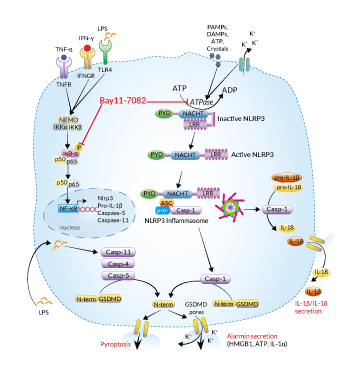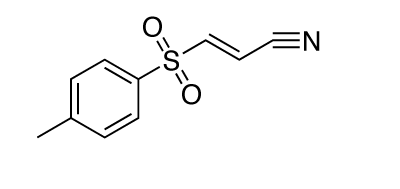NF-κB and NLRP3 inflammasome inhibitor - BAY 11-7082
| Product | Unit size | Cat. code | Docs. | Qty. | Price | |
|---|---|---|---|---|---|---|
|
BAY 11-7082 IκB-α inhibitor - NLRP3 inflammasome inhibitor - InvitroFit™ |
Show product |
10 mg 5 x 10 mg |
tlrl-b82
|
|
NF-κB inhibitor - NLRP3 inhibitor

Inhibitory activity of BAY 11-7082
BAY 11-7082 was first described as an irreversible inhibitor of the NF-κB pathway [1]. A number of reports have since shown that BAY 11-7082 has multiple targets, including the NLRP3 (NOD-like receptor pyrin domain-containing protein 3, cryopyrin, or NALP3) inflammasome sensor [2]. The multiprotein NLRP3 inflammasome complex is a key player in innate immunity.
Modes of action:
Inhibition of NF-κB translocation into the nucleus: BAY11-7082 inhibits the phosphorylation of IκB-α, which is essential for the release of NF-κB from the cytosolic IκB-α/ NF-κB complex [1]. The transcription factor NF-κB regulates multiple aspects of innate and adaptive immune functions and serves as a pivotal mediator of inflammatory responses.
Inhibition of inflammasome responses: BAY 11-7082 may inhibit the inflammasome responses indirectly by preventing the nuclear translocation of NF-κB at the priming step. Moreover, BAY 11-7082 has been shown to exhibit direct inhibitory functions on the NLRP3 inflammasome by blocking the sensor's ATPase activity [2].
Key features:
- Potent inhibitor of NF-κB and the NLRP3 inflammasome
- Does not inhibit the NLRP1 inflammasome
- InvitroFit™ grade: each lot is highly pure (≥95%) and functionally tested
![]() Read our review on the NLRP3 inflammasome.
Read our review on the NLRP3 inflammasome.
![]() Download our Practical guide on Inflammasomes.
Download our Practical guide on Inflammasomes.
References
1. Pierce JW. et al., 1997. Novel Inhibitors of Cytokine-induced Ikappa Balpha Phosphorylation and Endothelial Cell Adhesion Molecule Expression Show Anti-inflammatory Effects in Vivo.J. Biol. Chem., 272: 21096.
2. Juliana C. et al, 2010. Anti-inflammatory Compounds Parthenolide and Bay11-7082 Are Direct Inhibitors of the Inflammasome. J. Biol Chem. 285(13): 9792–9802.
Specifications
Working concentration: 1-10 μM
CAS number: 19542-67-7
Molecular weight: 207.25 g/mol
Solubility: 25 mg/ml in DMSO and 15 mg/ml in ethanol
Quality control:
- Purity: ≥95% (UHPLC)
- The inhibitory activity of the product has been validated using cellular assays.
- The absence of bacterial contamination (e.g. lipoproteins and endotoxins) is confirmed using HEK-Blue™ TLR2 and HEK-Blue™ TLR4 cells.
Contents
BAY 11-7082 is available in two quantities:
- tlrl-b82: 10 mg
- tlrl-b82-5: 5 x 10 mg
![]() BAY 11-7082 is shipped at room temperature.
BAY 11-7082 is shipped at room temperature.
![]() Upon receipt, store at -20°C.
Upon receipt, store at -20°C.
Back to the top
Details
The NLRP3 Inflammasome:
The NLRP3 inflammasome is an innate immune sensor that is activated by a two-step process; a first signal (‘priming’) provided mainly by bacterial components or endogenous cytokines involves NF-κB induction, while the second signal provided by a wide array of stimuli including microbial toxins, endogenous molecules or crystalline substances and leads to inflammasome assembly and activation [1, 2]. This triggers inflammasome multimerization and caspase-1 activation with the subsequent cleavage of interleukin-1β (IL-1β)/IL-18 and the pore-forming protein Gasdermin D (GSDMD) into their active forms. Additionally, the activation of the inflammasome also leads to alarmin secretion and pyroptosis, a form of immunogenic cell death.
1. Swanson K.V. et al., 2019. The NLRP3 inflammasome: molecular activation and regulation to therapeutics. Nat. Rev. Immunol. 19:477.
2. Groslambert M. & Py B. 2018. Spotlight on the NLRP3 inflammasome pathway. J. Inflamm. Res. 11:359.
Chemical structure of Bay 11-7082:







